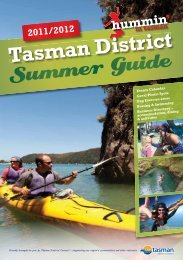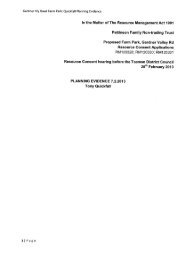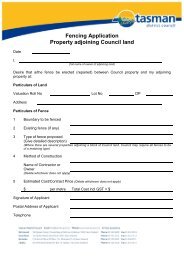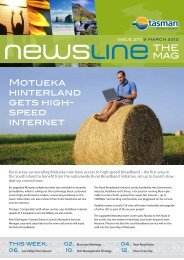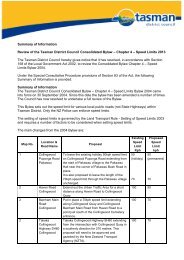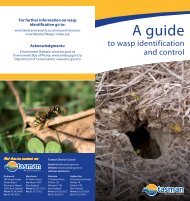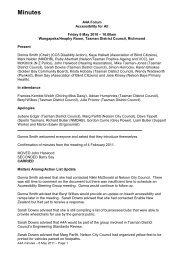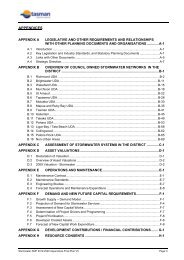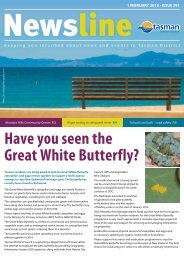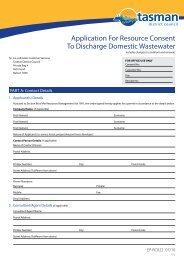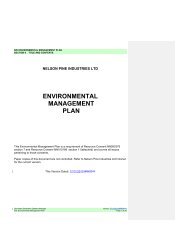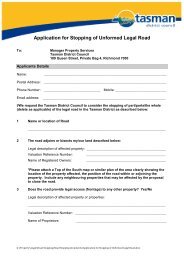Abel Tasman Foreshore Scenic Reserve Draft Management Plan
Abel Tasman Foreshore Scenic Reserve Draft Management Plan
Abel Tasman Foreshore Scenic Reserve Draft Management Plan
You also want an ePaper? Increase the reach of your titles
YUMPU automatically turns print PDFs into web optimized ePapers that Google loves.
(v)<br />
Indigenous bird habitats<br />
(see Appendix 7 for the New Zealand threat classification system)<br />
The islands along the <strong>Abel</strong> <strong>Tasman</strong> coast are being managed as mammalian pest free<br />
areas. Islands with no predators, and generally lower human disturbance than<br />
mainland habitats, provide important habitats for birds which use or cross the<br />
intertidal zone within the reserve. Reef herons (‘threatened’ –‘nationally vulnerable’)<br />
are regularly observed on the islands and the more isolated parts of the mainland<br />
shore, and may breed at Taupo Point and on Pinnacle and Fisherman/Motuarero-iti<br />
islands. Blue penguins (‘at risk’ – declining’) breed on Adele/Motuarero-nui, Tonga<br />
and Fisherman/Motuarero-iti islands, and along the mainland shore. Spotted shags<br />
(not threatened) breed on the Tata Islands and roost elsewhere, including parts of<br />
Adele/Motuarero-nui and Fisherman/ Motuarero-iti islands. The granite reefs and<br />
rocky shores throughout the reserve also provide important habitat for banded<br />
dotterel (‘threatened’ – ‘nationally vulnerable’) and variable oystercatcher (‘at risk’ –<br />
‘recovering’).<br />
Sand spits within the reserve provide important roosting or breeding sites for birds.<br />
The largest sand spits are at Awaroa and Wainui inlets. Smaller sand spits are<br />
located at Totaranui, Torrent Bay/Rakauroa, Falls River, Bark Bay/Wairinga and<br />
Marahau. White-fronted terns (‘at risk’ – ‘declining’) breed at the Awaroa sand spit,<br />
and variable oystercatchers use most of the sand spits in the reserve, including those<br />
at Torrent Bay/Rakauroa, Awaroa and Falls River.<br />
The estuaries within the reserve seldom attract the large numbers of waders that<br />
utilise the extensive fine-sediment estuaries in the region such as Farewell Spit and<br />
Waimea Inlet. However, they do provide important unmodified habitats which may<br />
be used as stopover points for migrating waders. They also support approximately<br />
2000 South Island pied oystercatchers (‘at risk’ – ‘declining’) and 200 banded<br />
dotterels at various times through the year.<br />
Salt marsh and herbfield habitats comprise 23% of the estuarine areas within the<br />
reserve. This habitat, spread over 15 estuaries, provides critical habitat for<br />
approximately ten pairs of banded rail (‘at risk’ – ‘naturally uncommon’). Other<br />
‘threatened’ or ‘at risk’ bird species utilising estuarine habitats are the grey duck<br />
(‘threatened’ – ‘nationally critical’), Australasian bittern (‘threatened’ – ‘nationally<br />
endangered’), fernbird (‘at risk’ – ‘declining’), and marsh crake (‘at risk’ –<br />
‘recovering’).<br />
Table 1, Appendix 7 lists the ‘threatened’ and ‘at risk’ bird species that may be found<br />
in the reserve.<br />
(vi)<br />
Indigenous invertebrate habitats<br />
Invertebrate habitats within the reserve include granite shores, limestone shores,<br />
estuarine flats and sandy beaches. Fifty-three species of invertebrate have been<br />
recorded from granite shores within the reserve, compared with 27 species on<br />
limestone shores. Granite zonation patterns comprise a high tide zone dominated by<br />
two species of periwinkle, an upper tidal zone dominated by barnacles, a mid-tide<br />
zone dominated by barnacles and little black mussels, and a low tide zone dominated<br />
by tube worms. The zonation pattern on limestone is quite different, including the<br />
replacement of the granite barnacle species with another barnacle species, tube<br />
worms not confined to the one zone, the more common presence of a bryozoan<br />
species. A wide variety of invertebrate species are present on rocky habitats in the<br />
3. Conservation of natural resources 21



